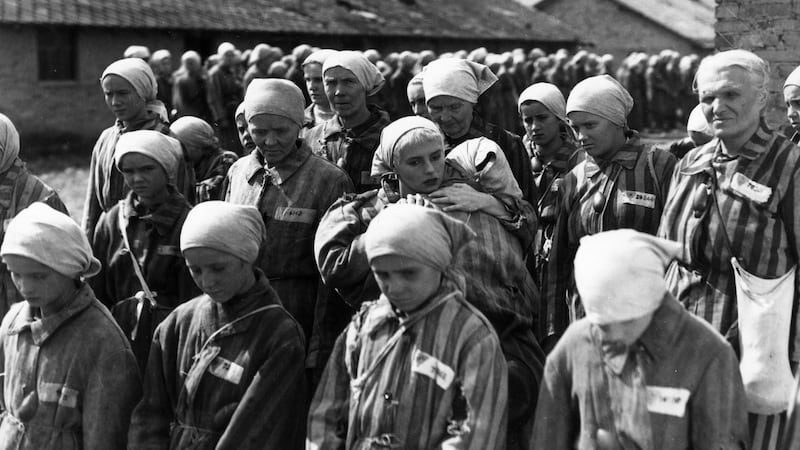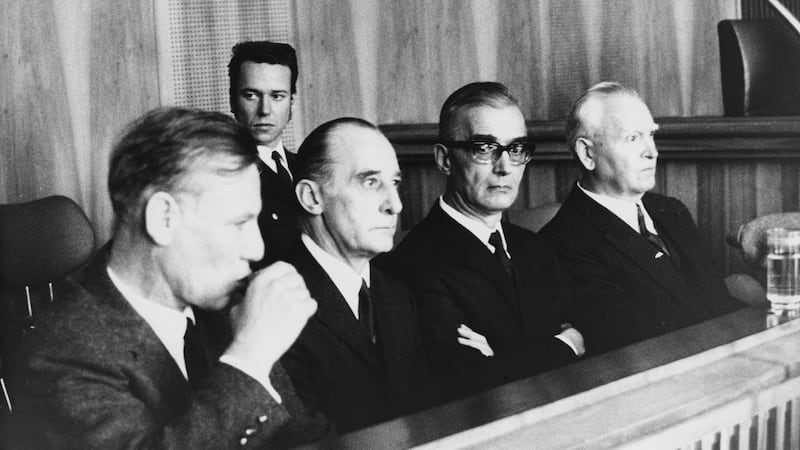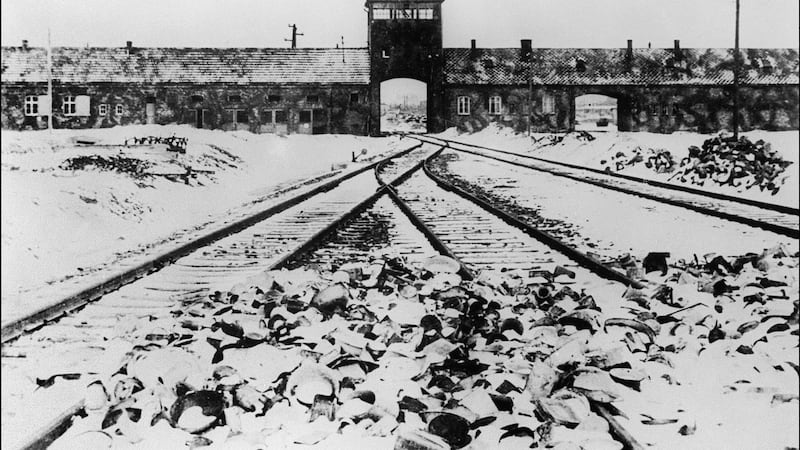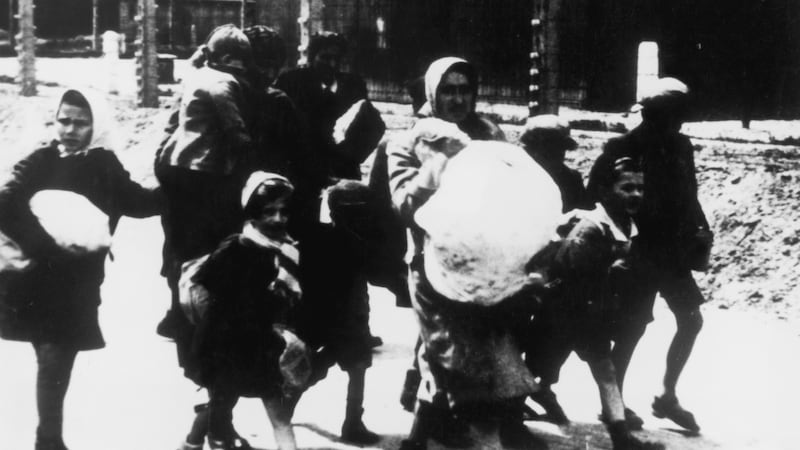‘P.J.” The letters were painted in ghostly white, a foot high on the wall, faded but legible beneath the veil of grime. I was seven years old when I noticed them, waiting with my father for the arrival of uncles and aunts at Southend railway station. What did the gnomic inscription mean? “Nothing; never mind,” he answered, but I remember the uneasiness written on his usually frank face. Later that day, when I asked again, he told me. The initials stood, he said, for “Perish Judah”. “Bad people, stupid people put them there; that’s why they’re rubbed out.”
I was struck (and scared) by the archaic ring of it, as if drawn from an Old Testament passage recording the proclamation of a Mesopotamian tyrant resolved to raze Jerusalem to the ground. My parents thought the graffito a relic of the Mosley years in the 1930s, when they and all their East End friends and neighbours had stood firm against the fascist march on Cable Street. But since the sighting was in 1952, I now realise there was another possibility.
Five years before, over a hot bank holiday weekend in August 1947, there had been a frightening outbreak of anti-Semitic rioting – especially violent in Manchester, Liverpool and Glasgow. The trigger had been the hanging in Palestine of two British army sergeants, Clifford Martin and Mervyn Paice, by the Jewish paramilitary group Irgun Zvai Leumi, three of whose members had been executed by the British authorities. The Irgun had committed terrorist acts including the bombing of the King David Hotel. The Jewish press in Britain and community leaders expressed horror and repugnance at the execution of the sergeants. But their condemnation was drowned out in the press uproar.

The popular mood in that summer of bitter postwar austerity was in any case ugly. The usual mutterings about Jewish profiteering surfaced. But the targets in 1947 were modest Jewish high-street shopkeepers whose premises were smashed up, windows daubed or shattered. Cheetham Hill in Manchester was carpeted with broken glass; the devastation severe enough to remind many of the Blitz. Just two years after the war had ended there was no shortage of those eager to hold all Jews responsible for the action of militant fanatics in Palestine. An anti-Semitic orator (and ex sergeant-major) called John Regan, speaking to a crowd of 700 in Eccles, bellowed: “Hitler was right. Exterminate every Jew – every man, woman and child.” “Hang all Jews” screamed another sign; there were similar anti-Semitic actions in Bolton, Holyhead, Hendon and, as it turned out, Southend.
Einsatzgruppen trial
At almost the same time, in the late summer of 1947, indictments were being filed by the American military authorities in Nuremberg against commanders of the Einsatzgruppen whose trial would open in September and continue through the spring. The commission that those “special task forces” received from Hitler, Heinrich Himmler and Reinhard Heydrich was to accompany the German invasion launched against the Soviet Union in the summer of 1941 through the Baltic states and Ukraine, and exterminate the Jews of that region along with Roma, the mentally handicapped and anyone judged to have been part of the communist regime.

They succeeded in that mission all too well. The killers kept meticulous records. Ronald Headland’s Messages of Murder (1992), which used them as a source, documents more than a million deaths of Jewish men, women and children between the summer of 1941 and the late spring of 1943, the vast majority taking place within the first six to nine months. With the exception of those killed in German-encouraged pogroms, especially in Lithuania, and some communities burned alive inside their synagogues, the million were all murdered by shooting.
Before the gas camps were conceived, then, entire populations in a huge swath of territory from the Baltic to Crimea were wiped out for the crime of being Jewish or Roma. Between June and November 1941, 177,000 Lithuanian Jews – or 80 per cent of the Jewish population – were murdered. In the city and neighbouring countryside around Kovno (Kaunas), the home of my mother’s family the Steinbergs, Lithuanian auxiliary police encouraged by the Germans killed 1,500 in a pogrom within days of the German arrival, and a further 2,800 in subsequent acts of violence – all this before organised executions. At Babi Yar near Kyiv, 33,771 were murdered in two days in late September 1941. Not all were liquidated in remote ravines and woods; many of the shootings took place in daylight and in the middle of towns. At Kamenetz-Podolsk, 23,600 were killed in three days; at Rovno, 15,000 in two days. Romanian killing squads slaughtered between 75,000 and 80,000 Odessa Jews.
Holocaust of the bullets
Nothing could be more fruitless than the tabulation of some sort of scale of comparative atrocity, but when the 75th anniversary of the liberation of Auschwitz is commemorated next week, the “Holocaust of the bullets” might be remembered too, since, as a baleful document of what humans are capable of doing to other humans, these mass murders may be even more dumbfounding than the gassings and incinerations of Auschwitz, Treblinka, Sobibor, Belzec and the rest. For the victims of the Einsatzgruppen were executed close up, by hand, as it were, aided by local “auxiliaries” who had been neighbours of those they were about to kill and bury in pits.
The Einsatzgruppen themselves numbered a mere 3,000. One of their officers in Lithuania estimated the ratio of Germans to locals in the firing squads to be one to eight. Work out for yourselves what that means. Women and children were executed in colossal numbers. Himmler made it plain that “I could not justify exterminating men and allow children to grow up to be their avengers.” The Nazi prime objective, after all, was to annihilate the Jewish future embodied in children and women of childbearing age.

All of this became exhaustively known during the Einsatzgruppen trials, as would the full enormity of the death camps of the “Final Solution”. But as we have discovered to our cost, neither irrefutable historical evidence nor proximity in time and place to the events immunised the world against the dehumanising prejudices consummated in the Holocaust. The degradations of anti-Semitism did not begin with the Nazis and would not end with them.
Nor did it predispose powers who had slammed the door of refuge in the face of the Jews in their time of most desperate need to feel especially tender-hearted towards survivors. Ernest Bevin, foreign secretary in the Labour government, formed a joint Anglo-American Commission on Palestine in 1945 as a way of preparing some shared responsibility. But when it recommended allowing 100,000 survivors to enter the country, Bevin and prime minister Clement Attlee ignored the proposal. No state was stepping forward with welcoming visas for those languishing in displaced-persons camps in Europe.
Survivors attempting to return to their countries of origin and reclaim homes and property were met with predictable hostility, sometimes violent, by those who had taken them in the presumed permanent absence of their prior owners. In Poland uneasiness about the inconvenient reappearance of Jews predictably led to the return of ancient anti-Semitic demons. In Kielce in 1946, the disappearance of a Christian child triggered yet another edition of the blood libel (invented in medieval England) by which Jews were said to require the blood of Christians for their Passover matzot. The resulting pogrom ended in the death of 40 Jews. The Polish government became eager to encourage Jewish emigration and the offer was swiftly accepted by the vast majority of the surviving 200,000 (out of a prewar population of three million).
Refuge established
Nonetheless, the world I grew up in during the 1950s seemed, finally, to have put the nightmare of exterminating anti-Semitism behind it. Israel had been established as the refuge no other countries had given. It did not escape my generation’s attention that had El Alamein gone the other way, there would have been another Holocaust. The failure of Arab armies to crush the infant state at birth in 1948 seemed miraculous. If we were ignorant of the magnitude of the Palestinian trauma, the 800,000 of the Nakba who fled or were forced from their homes, we were also largely ignorant of the tragically symmetrical trauma of the Jews of Arab countries, brutalised, persecuted and expelled from their ancestral homes in Yemen, Egypt, Syria and Iraq – the catastrophic uprooting of 800,000 Arabic-speaking Mizrachi Jews.
In postwar Britain, on the other hand, Jews seemed comfortably at home. They were a conspicuous presence in science and arts, the media and the academy. If Attlee and Bevin had been hostile to the establishment of a Jewish state in Palestine, a core of Labour including Aneurin Bevan, Herbert Morrison, Hugh Gaitskell and the young Harold Wilson were all champions. With the Mapai/Labour party and the Histadrut unions dominating Israeli politics there was an assumed affinity with British Labour. There was no need for the Labour Friends of Israel to feel defensive.
In the US anti-Semitism seemed confined to a lunatic fringe, even when in 1958 the Hebrew Benevolent Congregation Temple in Atlanta was bombed by white supremacists accusing the Jews not just of aiding and abetting the civil rights movement (guilty as charged) but creating the campaign expressly to destroy white Christian America. An almost identical argument would be made 60 years later, online, by Robert Bowers when he insisted George Soros and Jewish money were behind caravans of Latino migrants that the president had described as an invasion. Believing himself to be a good patriot soldier, Bowers reached for his guns and headed towards the Tree of Life synagogue.
Historians aren’t prophets; I didn’t see this coming from either extreme, right or left. The election – and re-election – of Barack Obama seemed to suggest that white nationalists could foam with rage but to little political effect. I hadn’t anticipated how populist rage against minorities (and there had been a strain of anti-Semitism in the American populism of the early 20th century) would go dangerously mainstream.
As for the anti-Semitism of the left, during the 1950s and early 1960s, when Israel was social democracy’s darling, it seemed unlikely that Labour governments in that country would be decisively replaced by right-wing nationalists. In 1977 Menahem Begin won the first majority for Likud. Then came the lethal symmetry of competing messianisms: intifada and jihad on the one side; biblically invoked settlements on the other. With dismaying speed, criticism of the actions of successive Israeli governments mutated into denials of Israel’s right to exist at all.
Zionism, which is no more than the acceptance of that right, became the common anathema of the racist right and the hard left; anti-Zionism degenerated into conspiratorial, dehumanising anti-Semitism. And now we have reached the point where a head of government – Malaysian prime minister Mahathir Mohamad – can speak to students at universities in the US and England despite having called Jews “hook-nosed”, said they “rule the world by proxy”, questioned the numbers killed in the Holocaust and stated that he was “glad” to be called an anti-Semite.
But then, after 1952 I had never seen another anti-Semitic daub deface a British wall; until, that is, the past few years, when swastika and blood-red star of David graffiti on high-street windows have appeared with sinister regularity. Something about our times – the hatred of the immigrant and the foreign – has given permission for an epidemic of cemetery desecration; painting a swastika on a tombstone, is, after all, just an extension of the kind of dehumanising mania that emboldens racists to scream abuse at Americans speaking Spanish in a supermarket or at British Muslim women on a London bus.
Poison pit
So here we are now, deep in the poison pit where Jews are blamed and physically assaulted both for being insufficiently integrated and for being excessively integrated (the better to conspire to dominion over the media, finance, politics and so on). This lose/lose predicament in which, historically, Jews were subject both to expulsion or physical separation from non-Jewish populations (hence the ghetto) and (as in the French revolution) ordered to assimilate so completely that they relinquish their own cultural and religious identity, was the heart of Theodor Herzl’s case for Zionism in Der Judenstaat.
It was the impossibility of meeting these two demands simultaneously that led to the persecution and judicial murder of “New Christian” converts in Spain and Portugal (at least a thousand killed over two days of Easter in Lisbon in 1506) and which Herzl accurately predicted would some day lead to an immense annihilation of both pious and impious Jews (like himself). Hence the existential need for a place of their own where both norms of being Jewish could live side by side (if not uncontentiously) without being thrown on the tender mercies of others who time after time, when it came to the rub, confined their concern for the fate of Jews to the expression of well-meaning sympathies.

This impossible predicament of the diaspora has already begun to take lives – in the US, in France – though no state government has yet come to power with anti-Semitism as its manifesto. As friends of mine pointed out when the spectre of new anti-Semitism raised its head a decade or more ago, Hitler is indeed dead. But there are other ways to kill off the safety of being Jewish in a non-Jewish world and those amounting to a passive deprivation of basic civil rights are legion today.
Jews are told by well-meaning authorities that they cannot walk down a street wearing a kippah skull cap, much less the garb of an ultraorthodox Haredi, if they wish to be safe. Attending a synagogue service routinely means passing through armed security guards. Nor may they defend Zionism without incurring a storm of murderous online trolling. Israel, we are told, is the new reich and those of us committed to its existence (not all of its policies) are the new Nazis. The International Holocaust Remembrance Alliance included this grotesque equation in its definition of anti-Semitism. It was when Labour originally declined to accept that part of the definition that another round of recrimination began.
So the gathering of the good and the great in Jerusalem on January 27th to commemorate the liberation of Auschwitz is right and proper, and a sign – also given by the likes of Emmanuel Macron and, most movingly, Angela Merkel in a visit to the death camp – to treat this ongoing dehumanisation with the utmost urgency.
While what Jews have suffered over centuries may be incommensurably more monstrous in both enormity and regularity than any other people facing genocidal destruction and institutionalised racial dehumanisation, there is nothing whatsoever to be gained by any kind of competition for ultimate victimhood. It ought not to be impossible to acknowledge the suffering and mistreatment of Palestinians while also acknowledging the terrible uniqueness of the industrial programme to wipe Jews from the face of the earth.
Connectedness
The greater point, though, is connectedness. The reason why the likes of Émile Zola sprang to the defence of Dreyfus and into combat with the anti-Semite Edouard Drumont – whose acolytes and devotees, at one especially odious moment in 1899, proposed a wide variety of “solutions” to deal with the Jews of France, including turning them into dog food, subjects for medical school vivisection and target practice for artillery – was that Zola saw the integrity of republican democracy itself as contingent on treating the Jews as full, patriotically loyal citizens.

So too, now, any campaign against anti-Semitism is necessarily a campaign for the basic decencies of liberal democracy; a consistency of principle which makes Jews not just the kin of other people who have suffered genocide – Armenians, Bosniaks and Tutsis, for instance – but of those currently suffering the theft of civil rights on account of their race or religion: the Uighurs, Rohingya, the defenceless children of Latino fugitives from terror and dispossession in their homes; and, indeed, Palestinians living under the daily hardships and injustices of occupation.
What, then, is the purpose of acts of remembrance of the kind that will take place at Auschwitz and Jerusalem; who are they for? To begin with, in the age of disinformation when Holocaust denial has become commonplace and more are taken in by the demonising forgery of the Protocols of the Elders of Zion through online access to the libel; at a time when the power of evidence has to contend with the intoxication of malignant belief; at a moment when those who went through the tormenting fires themselves are leaving us, it is essential that the cautionary history be imprinted in the minds of the future.
But this should be not done just to vindicate the survivors and the millions whose bodies were turned to smoke, or whose bones still lie in the mass pits of eastern Europe. It should also be done, especially in this wretched time of tribal shrieking, for the sake of our common humanity. If the story represents the very worst that humans can do, and must not do again, the act of telling is also a reassertion through horrified decency of the mutual care and kindness of which humanity must yet be capable.
Simon Schama is an FT contributing editor
– FT Service














